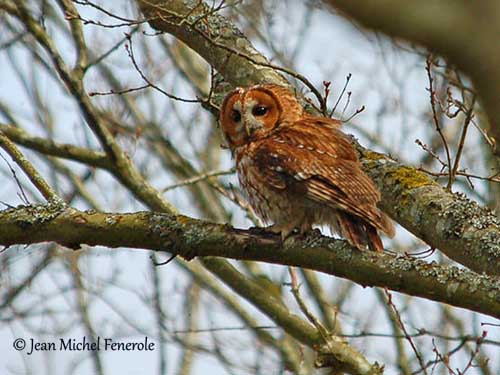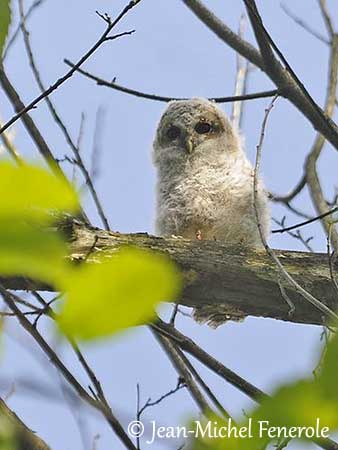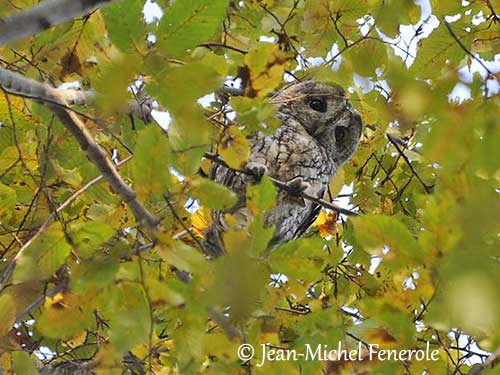
Fr: Chouette hulotte
All : Waldkauz
Esp : Cárabo
Ital : Allocco comune
Nd: Bosuil
Sd: Kattuggla
Photographers:
Jean Michel Fenerole
Photos d’Oiseaux du monde
Steve Garvie
RAINBIRDER Photo galleries
Text by Nicole Bouglouan
Sources:
HANDBOOK OF THE BIRDS OF THE WORLD Vol 5 by Josep del Hoyo-Andrew Elliott-Jordi Sargatal - Lynx Edicions - ISBN: 8487334253
THE HANDBOOK OF BIRD IDENTIFICATION FOR EUROPE AND THE WESTERN PALEARCTIC by Mark Beaman, Steve Madge - C.Helm - ISBN: 0713639601
THE COMPLETE BOOK OF BRITISH BIRDS – Written by “Royal Society for the Protection of Birds” experts - Préface de Magnus Magnusson - Michael Cady- Rob Hume Editors - ISBN: 0749509112
ENCYCLOPEDIE DES OISEAUX DE FRANCE ET D’EUROPE – de Peter Hayman et Rob Hume - Flammarion – ISBN : 2082009920
BirdLife International (BirdLife International)
Wikipedia, the free encyclopaedia
Tawny Owl
Strix aluco
Strigiforme Order – Strigidae Family
BIOMETRICS:
Length: 37-39 cm
Wingspan: 94-104 cm
Poids: M: 440 g – F: 553 g
DESCRIPTION:
The Tawny Owl is a stocky bird with fairly large, rounded head. There are several morphs which differ mainly in plumage ground colours, from deep rufous-brown to dark grey, with intermediates. The plumage is always cryptic, allowing the bird to remain invisible when resting in tree by day.
The adult of nominate race “aluco” is grey-brown. Upperparts are heavily mottled brown, and show darker shaft streaks. Wing-coverts and outer scapulars show large white spot at tip, forming a line. The tail is barred dark.
Underparts are paler and streaked dark, with variable narrow cross-bars.
On the head, the face is rounded. The facial disk is usually pale but with some darker concentric circles. The centre of the crown is dark brown, bordered by whitish bands.
The bill is horn-coloured. The eyes are dark brown. The legs and most of the toes are feathered.

Both sexes are similar in plumage, but the female is slightly larger than male.
The juvenile is paler and has shaggy, loose plumage, more finely barred.
We can find eleven subspecies throughout the range. They differ in colour and size, but the basic pattern is similar.
VOICE: SOUNDS BY XENO-CANTO
The Tawny Owl has large repertoire of calls, and there are some variations between sexes. It utters a long, quavering hoot during which faint monosyllables and short pauses are interspersed, and ending in soft, long tremolo falling in pitch.
During the courtship displays, it utters long trills, but also “quit” contact calls. A sharp “kewick” is mostly heard in spring and summer, when the bird is excited or aggressive.
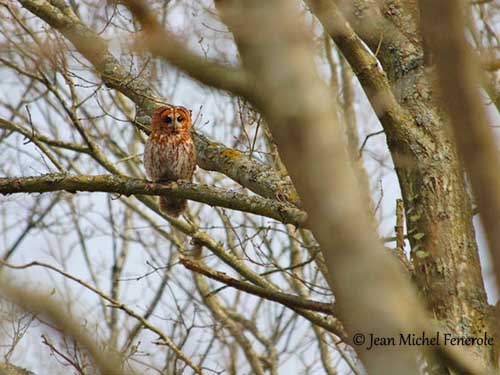
HABITAT:
The Tawny Owl frequents open and semi-open forests and woodlands, also farmlands, parks, gardens, villages and towns, usually any area with trees.
This species occurs from the boreal zone fringe, through more temperate areas to Mediterranean zones. It is mainly seen in lowlands, but according to the range, it can be seen up to 2350 metres of elevation in Turkey and Turkestan, and even up to 4250 metres in the Himalayas where it may live above the tree-line.
RANGE:
The Tawny Owl is resident throughout the wide distribution across temperate Eurasia, from W Europe (Great Britain and Iberian Peninsula), to Korea, and southwards to Iran and the Himalayas.
The race S.a. mauritanica occurs in NW Africa.
The species is absent from Ireland, and a rare vagrant to the Balearic and Canary Islands.
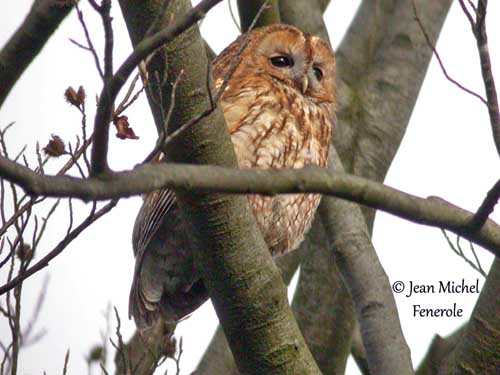
BEHAVIOUR:
The Tawny Owl feeds primarily on small mammals such as mice, voles and shrews, but also up to size of squirrels and young rabbits. Small birds up to size of pigeon, amphibians, reptiles, earthworms, snails and insects are taken according to the area and prey availability.
It hunts by night, between dusk and dawn, but it may occasionally be diurnal. It hunts usually from perch and locates the preys by sound. It performs short flights and returns to the same perch.
It drops onto the prey and extends the wings on impact to cover and strike the prey.
When hunting over open areas, it flies slowly, performs some glides, hovers and makes zigzag searches.
It may take some fish from water surface while flying. It is able to catch large insects and bats in flight. The prey is eaten on elevated perch.
As other Strigidae species, the Tawny Owl regurgitates pellets of undigested parts such as bones, teeth, fur, feathers…
The male performs territorial fights to establish the territory while the female chooses the nesting hole. This aggressive behaviour starts in October/November. Then, following the establishment of territory and nest-site, both mates often roost together.
The male performs courtship feeding to the female. Some displays show the male perched near the female and swaying from side to side, but also up and down. It raises first one wing and then the other, and at the end both wings together.
Other displays include puffed out plumage, making the male almost round. Some soft grunts can be heard. It also performs wing-clapping and pursues the female. She also may puff out and quiver her feathers.
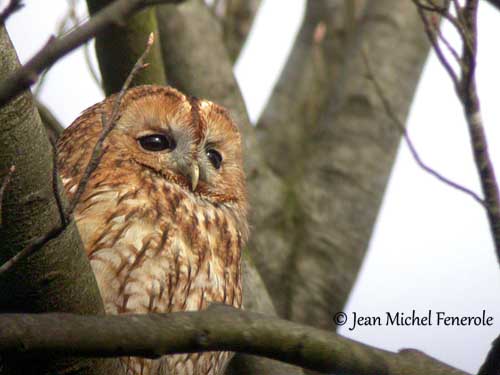
The Tawny Owls are usually monogamous and the pair-bonds last for life. They are resident within their territory, whereas the juveniles disperse by late autumn.
FLIGHT:
The Tawny Owl flies with soft, silent wing-beats, and often performs short glides.
REPRODUCTION:
The breeding season occurs between February and July.
The Tawny Owl nests in natural cavities or nest-box in tree. It may also use chimneys and ledges in old buildings. Abandoned nests of Corvidae species or Birds of prey can be used too, as well in trees as on cliffs or bare ledges. In SW Scotland (Galloway), this species commonly nests on the ground.
The female lays 2-6 eggs, sometimes only one. She incubates alone during 28-30 days, and she is fed by the male during this period. The chicks are covered with white down, and are brooded during two weeks by the female. They fledge 32-37 days after hatching, but often leave the nest at 25-30 days, and remain on the nearby branches. They are independent at 3 months old. They can breed at 1-2 years.
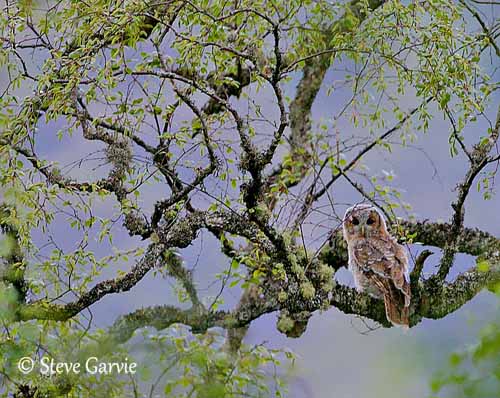
DIET:
The Tawny Owl feeds on small mammals such as mice, voles, shrews and young rabbits. It also takes birds up to size of pigeons, earthworms, insects, frogs, fish, lizards, molluscs and crustaceans.
It hunts from perches or while flying.
PROTECTION / THREATS / STATUS:
The Tawny Owl is usually common throughout the range in spite of collisions with vehicles, trains and wires.
The species is not currently threatened.
